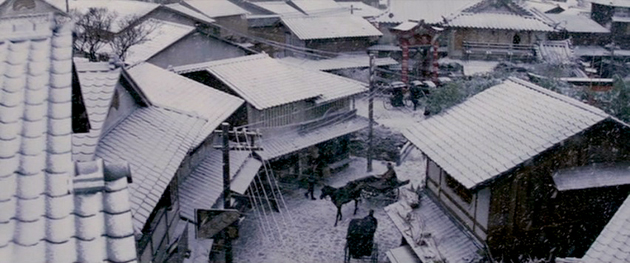John Myhre

At one point we had twenty drafts-people on just to draw every detail and every building and figure everything out. We came up with an idea that we would start at one end. So we started at the north side and we drew up one building that was going to be on the north side and then we started drawing the second building and the third building. While we were building we were still drawing what was in the middle. When the north side was completely built and when the woodwork was all up and it was sandblasted and it was stained we started dressing before we even finished drawing the buildings that were all the way to the south. And then they changed the schedule around a little bit and pushed the city up a couple weeks. So we were still busy, busy, busy building and dressing on the first day of photography. And Rob Marshall, the director, changed the schedule a bit to give us a little breathing room with it.
AS: You did interiors there also?
JM: We did a couple of partial interiors. We probably had ten exteriors incorporated within our city that were characters in our film. Mameha’s and the okiya and the tea house and for each of those locations we had a cutting-piece room so you could go through a doorway and enter into a room instead of it just being a doorway that would open into a piece of black. And then we repeated that doorway on a soundstage, in our set. All of the major interiors were done back at SONY. We wanted to make it as nice of an experience for the actors as we could. Being warm and comfortable and allowing Dion to light was important for us.
AS: I heard you made a little scale model and flew a little camera through…
JM: Yes, I work a lot with models and I find it’s a really good way of communicating what we do. We can always show people illustrations but it’s only from one view. We look at a blueprint but a lot of times it’s hard for people who are not used to blueprints to really understand them. So I never build a set without having built a model first.
We normally start with very, very simple, foam-core models. A long time ago John Boorman taught me a trick and I can’t thank him enough. Build a simple, little, foam-core model of what you’re proposing. Then get a video camera, these little tiny lipstick cameras, and, while they’re not absolutely accurate, you can drop it into the set with a couple of figures and see the view on a monitor. What’s also fun with the monitor is you can make mattes to show what the different film formats could be. Because I’ve actually been on films where they’re going, Well, do we do wide-screen or not widescreen? And if you have the two mattes or the variety of mattes for the different formats, you drop the camera into a set, a little foam-core set and it’s really interesting how much you can learn. You can move the camera through and look in all directions.
I always make sure I do it with not just the director but with the DP. The DP can go, Well, you know what, I’m really gonna need more light through here so we’ll put a window there. Or, This is a wall I’ll need to wild out. Or look at it and say, You know what, I can tell from the model I don’t need any ceiling panels.
With the John Boorman film we wanted this feeling that the family was always captured and so we always wanted to have walls on both sides of the frame. Never wanted to have something that felt open. That’s why we did this at first. And we literally took the walls of the model and just moved them in or out to get to where we wanted them to be. So I learned to be very sacrilegious with the models!
Pingback: David Warren
Pingback: Jess Gonchor
Pingback: David Wasco & Sandy Reynolds-Wasco